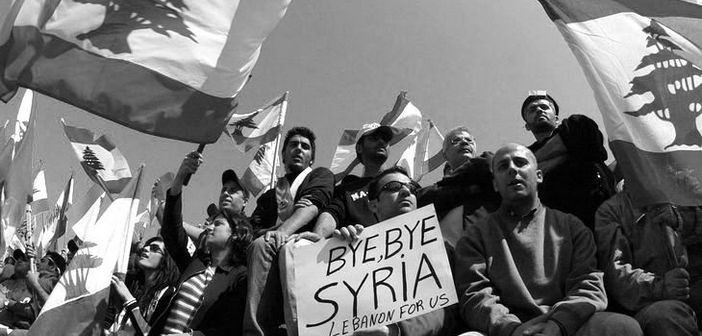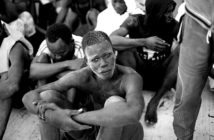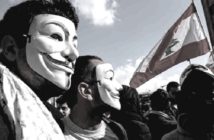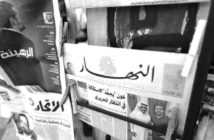“Beware of Small States” is what Mikhail Bakunin said in 1870. In this statement he refers to the price the neighbors will pay if they get involved in the affairs of small, vulnerable states. In fact, the 10,452 km² country, a small state with its multi-ethnic and multi-confessional population, Lebanon has always been “politically highly radioactive and extremely loud”. This political radio-activeness originates from its location between two countries, one that considers it as its “backyard” bound to it by “distinctive relations” and the other that considers it the battleground for its regional fighting. Lebanon took its current geographical frontiers in 1943, with the areas annexed by France in 1920 to create Greater Lebanon, after the signing of the 1943 Lebanese National Pact. It was only after providing reassurance to Syria that “Lebanon will not constitute a beachhead or a corridor for Arab or foreign actors bent on destabilizing the Damascus regime” (B. Salloukh, Syria and Lebanon and Brotherhood Transformed), that the signing could take place.
ملخّص
لم يذهب عبثاً قول الثائر الروسي ميخائيل باكونين “حذار من البلدان الصغيرة” في العام 1870 وعنى بذلك أن الثمن الذي تدفعه الدول لقاء تدخلها في شؤون الدول الصغيرة هو باهظ جداً. وصدق هذا القول في دولة لم يتعدّ حدودها ال 452 10 كلم مربّع فبات لبنان ساحة صراعٍ لجيرانه في الجنوب ومكسب رزقٍ لجارته في الشمال. فلطالما جمعت بلبنان وشقيقته سوريا “علاقات مميزة” لدرجة أنها محت الحدود بينهما وتعدّت على الأراضي اللبنانية بغية ضمّها لأراضيها. فلبنان في نظر نظام الأسد هو جزء من سوريا الكبرى سلخ عنها منذ عهد الإنتداب الفرنسي فغدت مهمتها استرجاعه.
وكانت الفرصة مؤاتية للنظام يوم 24 أكتوبر/تشرين الأول 1989 حين عقد اجتماع في مدينة الطائف في السعودية نتج عنه معاهدة سعودية أميركية وسورية فرضت أحكامها على النوّاب اللبنانيين. كانت هذه المعاهدة باباُ لتغيرات جذرية داخل الدولة اللبنانية تخدم مصالح سوريا تحت شعار الحفاظ على التوازن الطائفي.
Syria’s Western Coast
Syria never considered Lebanon as an independent state rather as its extended western coast, contrary to all historical and geographical evidences. Its hegemonic views are translated into its educational system. Indeed, in the eyes of Syria, Lebanon is its extended territory that was ripped from its stronghold. It was with the signing of the Taef Agreement on 24 October 1989 that a new opportunity to retrieve what they believe was taken away came along. Concluded in Saudi Arabia, in Taef, the Accord, as wrote B. Salloukh, was the result of an “agreement between Saudi, US and Syria imposed on the Lebanese deputies.” In many ways, this agreement played in favor of Syria. As such, Syria was considered the ultimate “balancer of power” among the different Lebanese communities and “linked by distinctive relations to the country”. Also, the Accord gave a leeway to Syria on the Lebanese constitutional system and the judicial and security apparatus. It also provided the path to “redeploy” troops as “peacekeeping mission” to the Bekaa Valley, “Syria’s soft underbelly”. These troops were considered a matter of bilateral agreement between Syria and the future Lebanese government; yet, no assurance or timetable that details the withdrawal of the Syrian troops from the Lebanese premises was provided. Hence, the Taef opened the door for a constant Syrian presence that exacerbated the patience of the Lebanese population and led to several bloody upheavals. Syrian custodianship over Lebanon was blessed by the tacit acceptance of the US that wanted to include Syria in its coalition against Saddam in the 1990 when he invaded Kuwait and wanted to assert himself as a leader in the Arab world.
From 1990 to 2005, Syria had a free hand over Lebanon’s domestic and foreign politics. On a domestic level, it controlled the security apparatus. This domination took the form of a Treaty of Brotherhood, Cooperation and Coordination signed on 22 May 1991 as well as the Defense and Security Pact (DSP) signed in September 1991. The Syrianization of Lebanon was de facto and the jure. Article 1 of this Treaty of Brotherhood explicitly stated that “the two countries will work to achieve the highest levels of cooperation and coordination in all political and economic and security and cultural and scientific and other fields”. This means that Syria had a say in all decision-making and it aimed to “streamline the security and defense establishments of the two countries in a pro-Syrian ideological orientation to ensure Syria’s domination over Lebanon’s military establishment and intelligence apparatus.” Indeed, this mirrored Syria’s domination of Lebanon along with several examples: in 1990, the Presidential Palace located in Baabda was invaded by the Syrian army that took over all the confidential files related to the military, Syrian air attacks were initiated, unjust economic arrangements in favor of Syria’s economy were settled such as the arrangements related to the Lebanese river in Laboui and Assi River, 10% and 8% were respectively owned by Lebanon and the rest was under the Syrian control. Lebanon played an open market for Syrian goods that passed through the Lebanese territories then shipped by sea without any fees. The Syrian intelligent apparatus (mukhabarat) had an imminent role and could “veto all important political decisions, selection of the president, prime minister and key minister” (A. Knudsen, Precarious Peacebuilding: Post-war Lebanon). Even the Lebanese president was pro-Syrian i.e. Emile Lahhoud elected by a Syrian-Lebanese committee that bypasses the Lebanese Constitution. The Lebanese foreign politics were also intertwined with Syria’s; the Resolution 425 of the United Nations Security Council: “the linchpin of Lebanese diplomacy since the first Israeli invasion in 1978” linked the negotiations on the Lebanese track with those of the Syrian ones. In 1996, Assad negotiated on behalf of Lebanon when Israel launched the operation Grapes and Wrath.
The 1990s were also known as the period of unjust detentions and kidnapping of many young Lebanese political activists as well as political leaders. Christian nationalists such as Michel Aoun rejected the Taef and “charged with mutiny and embezzlement of public funds” that led him to be indicted for lifetime prison, so he was exiled to France as well as Etienne Sacre, leader of the right-wing nationalist movement Guardian of the Cedars, who has been sentenced to death in absentia. Samir Geagea, leader of the Lebanese Forces, was imprisoned for life for crimes he did not commit. Politicians were not the only ones targeted by the Syrian regime but also young Lebanese activists. The history of the Lebanese detained in Syrian prisons still lingers till today. Since 1976 and the Syrian domination of Lebanon, Lebanese were detained, interrogated, tortured and incarcerated in Syria never to see the light again; “sentences are swiftly pronounced by the military court without the right to appeal” (Report on Lebanese Detainees in Syria Prisons, August 2003, Lebanese Information Center, Washington DC). Detention was the way Syria dealt with the opposition of the Lebanese people to its hegemony. In addition, Syrian officials declared: “Lebanese parties who are launching a campaign against Syrian presence in Lebanon are serving Israel’s purposes and interests.” Arrests were arbitrarily executed; victims of enforced disappearance amounted to 200 according to back then the Lebanese President Elias Hrawi and the number was on a steady rise. Families used to receive the remains of their loved ones in ceiled boxes without having the right to any legal and medical investigation. The issue of the detainees remained a taboo until 1997, when the first Lebanese Committee of the families of detainees in Syria was established to pressure the authorities to look into this matter and to demand a fair trial in Lebanon for the Lebanese held in Syrian prisons. In 1998, Jamil al- Sayid, the deputy director of the military intelligence, and the pro-Syrian president Emile Lahoud governed the country. It was the Syrian security apparatus taking the form of fake civilian institutions that was in charge of the electoral processes, leading to “the amendment of a law organizing punitive litigation and passed on August 7, 2004, against the wishes of the majority of parliamentarians, ending the independence of the judiciary and giving the intelligence agencies free rein” (B. Salloukh).
The Turning point: UNSC Resolution 1559 and the Assassination of PM Rafic Hariri
Since the withdrawal of the Israeli soldiers from the South in 2000, the meetings calling for all foreign soldiers to withdraw from the Lebanese territories started to intensify. Headed by the Maronite Patriarch Mar Nasrallah Boutros Sfeir, two key meetings were held: 2001 meeting held in Cornet Chehwan and the Bristol meeting led by the opposition. These demands were supported by the International Community when on September 2, 2004, Washington and Paris pushed through UN Security Council Resolution 1559 calling on “all remaining foreign forces to withdraw from Lebanon” and mandating the “disbanding and disarmament of all Lebanese and non-Lebanese militias” in the country. Prime Minister Rafic Hariri joined at the time the opposition and was ready to take the lead once the Syrian apparatus was dismantled. With the rise of the international and national pressure, the Regime executed its final coup: on 14 February 2005, Beirut was shaken by an explosion that took the life of PM Hariri as well as many other civilians. This assassination led to the start of the most important revolution in the history of Lebanon; the Cedars’ Revolution. Lebanese united under one flag went to the streets, forgetting their religious and political differences. Lebanon wanted the truth behind the assassination and public outrage together with the entry into force of the 1559 UNSC resolution led to the withdrawal of all Syrian troops from the Lebanese territory.
In a nutshell, the Lebanese people lived in the shadow of a violent regime that thrived from the wealth of their home country, deprived them for decades from their basic needs and violated their basic human rights like the right to live. Ironically enough, time has changed and Assad directed his anger towards his population, which today seeks refuge in Lebanon, probably weakening its social structure and changing its demographical balance for the next decade to come. 2005 marked the beginning of the end of the Assad regime. His latest defeats and the ongoing conflict with the opposition highlight the regime’s last days.





